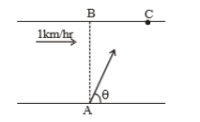A river is flowing with a speed of 1 km/hr. A swimmer wants to go to point 'C' starting from 'A'. He swims with a speed of 5 km/hr, at an angle with respect to the river. If \(\text {AB = BC = 400 m}\). Then


1. The time taken by the man is 12 min
2. The time taken by the man is 8 min
3. The value of is 45
4. The value of is 53


A body is thrown horizontally with a velocity \(\sqrt{2 g h}\) from the top of a tower of height \(h\). It strikes the level ground through the foot of the tower at a distance \(x\) from the tower. The value of \(x\) is:
| 1. | \( h \) | 2. | \(\frac{h}{2} \) |
| 3. | \(2 h \) | 4. | \( \frac{2 h}{3}\) |
A particle starts from the origin at t=0 and moves in the x-y plane with constant acceleration 'a' in the y direction. Its equation of motion is . The x component of its velocity (at t=0) is:
(1) variable
(2)
(3)
(4)
A body is projected with a velocity \(u\) with an angle of projection \(\theta.\) The change in velocity after the time \((t)\) from the time of projection will be:
| 1. | \(gt\) | 2. | \(\frac{1}{2}gt^2\) |
| 3. | \(u\sin\theta\) | 4. | \(u\cos\theta\) |
What determines the nature of the path followed by the particle?
(1) Speed only
(2) Velocity only
(3) Acceleration only
(4) None of these
A boat is sent across a river in perpendicular direction with a velocity of 8 km/hr. If the resultant velocity of boat is 10 km/hr, then velocity of the river is :
(1) 10 km/hr
(2) 8 km/hr
(3) 6 km/hr
(4) 4 km/hr
A boat is moving with velocity of in river and water is moving with a velocity of with respect to ground. Relative velocity of boat with respect to water is:
(1)
(2)
(3)
(4)
A boat moves with a speed of 5 km/h relative to water in a river flowing with a speed of 3 km/h and having a width of 1 km. The minimum time taken around a round trip(returning to the initial point) is:
(1) 5 min
(2) 60 min
(3) 20 min
(4) 30 min
A river is flowing from W to E with a speed of 5 m/min. A man can swim in still water with a velocity 10 m/min. In which direction should the man swim so as to take the shortest possible path to go to the south.
(1) 30° with downstream
(2) 60° with downstream
(3) 120° with downstream
(4) South
A train is moving towards east and a car is along north, both with same speed. The observed direction of car to the passenger in the train is
(1) East-north direction
(2) West-north direction
(3) South-east direction
(4) None of these






